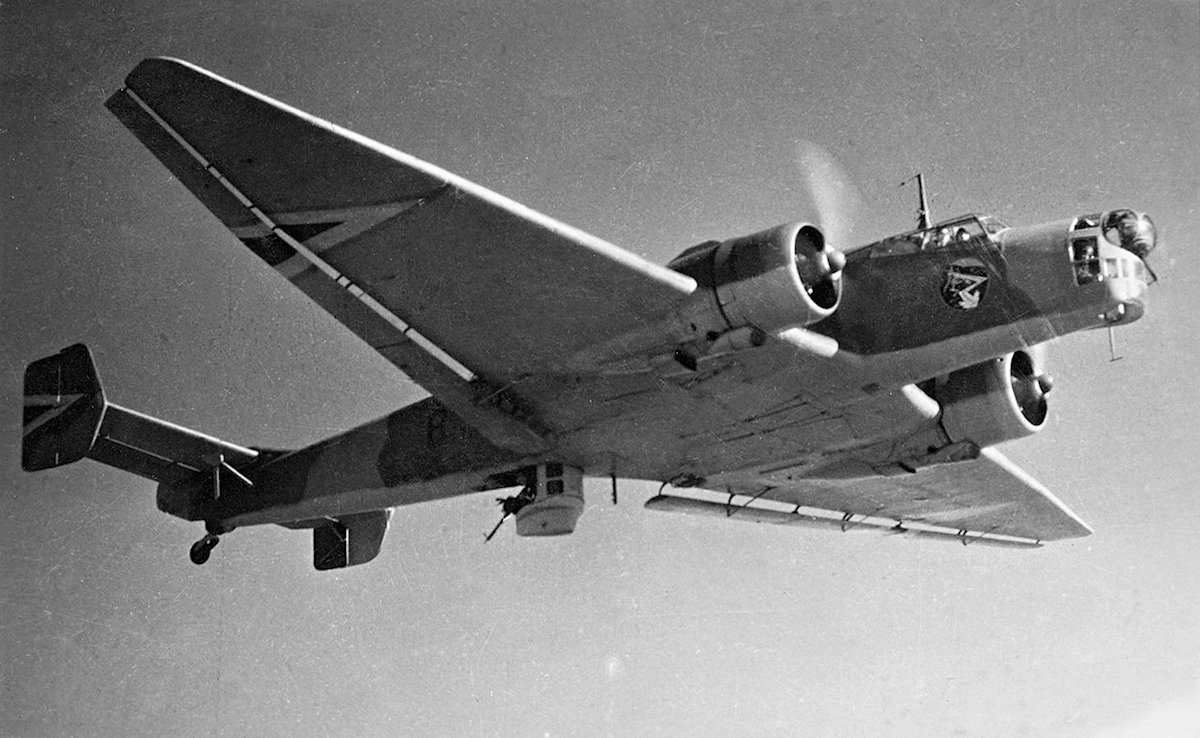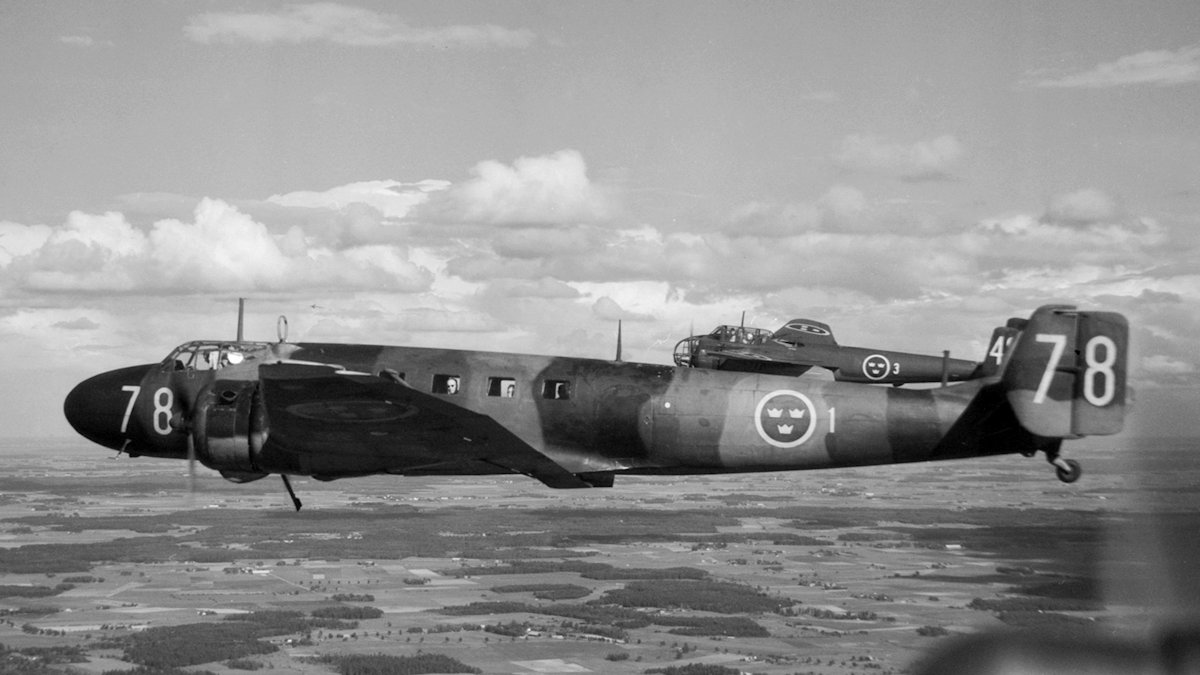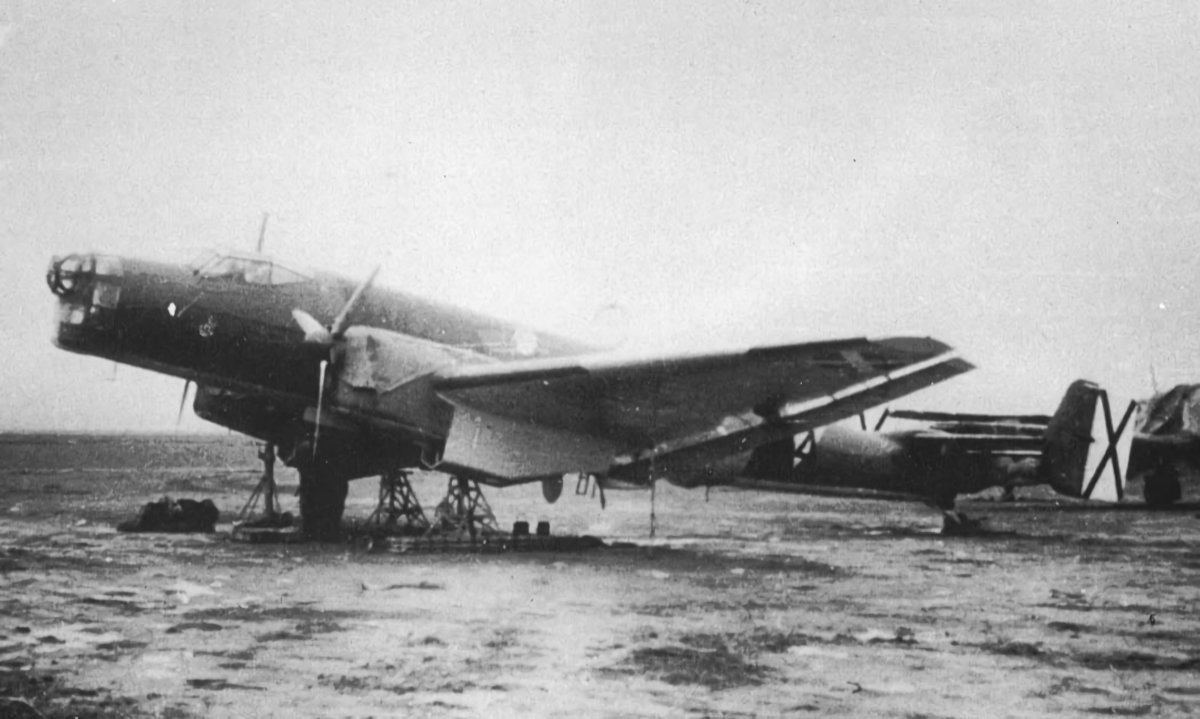Junkers Ju 86
Designed as both a bomber for the Luftwaffe and transport for Luft Hansa, the Junkers Ju 86 first flew on 4 November 1934. Four Ju 86D bombers were sent to Spain during the Civil War, where it was found that the diesel engines could not withstand rough treatment during combat. Although production switched to the E version with radial engines, it was inferior to the Heinkel He 111 and production was cut back.
By the start of the Second World War, the Ju 86 had been relegated to training units, apart from III./KG 1 “Hindenburg” which used them in Poland. During the attempt to supply surrounded German troops at Stalingrad in 1942, many Ju 86 were reallocated to transport units.
In 1940, the Luftwaffe had 40 early model Ju 86s converted to Ju 86P-1 high-altitude bombers and Ju 86P-2 photo-reconnaissance aircraft. During early 1941 the reconnaissance version flew sorties over Britain, but these stopped when Hitler invaded Russia (Operation Barbarossa). By mid-1942 the pressurized bomber version was available, and flew about a dozen nuisance raids over southern England. After the RAF mounted a special interception squadron using modified Spitfire Mk IXs, and one bomber attempting a raid on Portsmouth was intercepted on 12 September 1942, no further flights over England were attempted.
In August 1942, a modified Supermarine Spitfire Mark V shot one down over Egypt at an altitude of some 14,500 m (49,000 ft); when two more were lost, Ju 86Ps were withdrawn from service in 1943.
Military version were exported to several countries. Spain operated several ex-Legion Condor bombers.
The Royal Hungarian Air Force received the first of 63 Junkers Ju 86K-2 bombers in early 1938. These were used to bomb Slovakian airfields and defensive positions during the Slovak–Hungarian War in March 1939. From June 1941, the Ju 86s began to be replaced by Italian Caproni Ca.135 bombers. Both of these types were used during Hungary’s support of the German led invasion of the Soviet Union. Heavy losses led to the withdrawal of the Ju 86 bombers from frontline service during 1942.
- Australia
- Austria
- Bolivia
- Chile
- Germany
- Hungary
- Manchuria
- Portugal
- South Africa
- Spain
- Sweden
- Switzerland
Australia
Junkers Ju 86 Z Werknummer 086 0952 was built in1937 in Dessau, Germany and registered as D-AGEY. During March 1937, over a three-week period, it was piloted by Hans Kommoll on a ferry flight from Germany to Australia. Just before landing, an engine failed resulting in it swinging off the runway. It took about five weeks before a replacement engine arrived from Germany by sea.
On May 14, 1937 it was registered in Australia as VH-UYA and named “Lawrence Hargrave” for the British-born Australian engineer, explorer, astronomer, inventor and aeronautical pioneer. This aircraft was acquired by Sydney wool broker, H. Beinssen in exchange for £23,000 worth of Australian wool being shipped to Germany.
Placed on charter to Airlines of Australia Ltd. it was hoped that the diesel engines would prove more economical to operate than other aircraft. However, engine reliability problems resulted in the operator cancelling the lease. The aircraft was shipped back Germany in August where it became D-AREY.

Austria
The Republic of Austria ordered 12 Junkers Ju 86 bombers, although only three were actually delivered (in December 1937) before the Anschluss (the integration of Austria into Germany). At this time the three that had been delivered were back in Germany to have defects repaired.

Bolivia
Chile
The Chilean Air Force (Fuerza Aérea de Chile) operated 12 Junkers Ju 86 K-6 medium bombers powered by Pratt and Whitley Hornet engines. LAN also ordered three Ju 86Z airliners powered by Jumo 205 diesel engines, one of which was later transferred to the Air Force. Many of the Chilean Ju 86s were lost when the undercarriage failed due to rough and rocky airfields.

Germany
Designed as both a bomber for the Luftwaffe and transport for Luft Hansa, the Junkers Ju 86 first flew on 4 November 1934. Four Ju 86D bombers were sent to Spain during the Civil War, where it was found that the diesel engines could not withstand rough treatment during combat. Although production switched to the E version with radial engines, it was inferior to the Heinkel He 111 and production was cut back.
By the start of the Second World War, the Ju 86 had been relegated to training units, apart from III./KG 1 “Hindenburg” which used them in Poland. During the attempt to supply surrounded German troops at Stalingrad in 1942, many Ju 86 were reallocated to transport units.
In 1940, the Luftwaffe had 40 early model Ju 86s converted to Ju 86P-1 high-altitude bombers and Ju 86P-2 photo-reconnaissance aircraft. During early 1941 the reconnaissance version flew sorties over Britain, but these stopped when Hitler invaded Russia (Operation Barbarossa). By mid-1942 the pressurized bomber version was available, and flew about a dozen nuisance raids over southern England. After the RAF mounted a special interception squadron using modified Spitfire Mk IXs, and one bomber attempting a raid on Portsmouth was intercepted on 12 September 1942, no further flights over England were attempted.
In August 1942, a modified Supermarine Spitfire Mark V shot one down over Egypt at an altitude of some 14,500 m (49,000 ft); when two more were lost, Ju 86Ps were withdrawn from service in 1943.

Hungary
The Royal Hungarian Air Force received the first of 63 Junkers Ju 86K-2 bombers in early 1938. These were used to bomb Slovakian airfields and defensive positions during the Slovak–Hungarian War in March 1939. From June 1941, the Ju 86s began to be replaced by Italian Caproni Ca.135 bombers. Both of these types were used during Hungary’s support of the German led invasion of the Soviet Union. Heavy losses led to the withdrawal of the Ju 86 bombers from frontline service during 1942.

Manchuria
In 1938, Manchukuo (Manchuria) ordered ten Junkers Ju 86Z-2 airliners. These were operated until 1945.

Portugal
The Portuguese Air Force operated ten Junkers Ju 86K-7 bombers between 1938 and 1945.

South Africa
South African Airways ordered 17 Junkers Ju 86 airliners with the first arriving at the end of 1936. The first five aircraft were powered by Rolls Royce Kestrel engines and designated Ju 86Z-3. The airline raised concerns that these engines were unsuitable and the remaining aircraft used the Pratt and Whitney Hornet radial engines and were designated as Ju 86Z-7.
The South African Air Force also took delivery of a sole Junkers Ju 86K-1.
When war broke out, the planes were militarised and armed as bombers with defensive guns and external bomb racks. These aircraft were initially used for coastal patrols along with the sole Ju 86K-1, playing an important role in the interception of the German blockade runner SS Watussi in December 1939. In May 1940, they were used to re-equip No. 12 Squadron SAAF, which was deployed in the East African Campaign from June 1940. It flew its first bombing missions on 14 June 1940. As more modern aircraft became available, the South African Ju 86s were passed from squadron to squadron, seeing their last use with No. 22 Squadron SAAF, which used it along with the Avro Anson in the coastal reconnaissance role, finally retiring its Ju 86s in September 1942.

Spain
The German manned Condor Legion trialed four Junkers Ju 86D-1 bombers in Spain from February 1937. After flying several missions, one was shot down by Republican fighters. A replacement for the lost bomber was sent from Germany. However, two of the Ju 86s were lost in landing accidents resulting in the last two being sold to the Spain Nationalists. These were operated until at least the end of the Spanish Civil War.

Sweden
Sweden ordered 40 Junkers Ju 86 bombers which were delivered from 1936 to 1938. They were designated Ju 86K by Junkers and operated as the B3 by the Swedish Air Force (Flygvapnet). SAAB obtained a licence to produce an additional 40 aircraft, of which 16 would be from parts supplied by Junkers. However, only 16 were built before it was decided to terminate production to speed up production of the B5 (Northrop 8A).
During their service the JU 86Ks received engine upgrades to improve performance. They finished their service operating as transports with the last one being retired in 1957.
One Ju 86Z-7 was delivered to AB Aerotransport (ABA) for use as a mail carrier. It was later transferred to the Air Force where it was designated Tp9.

Switzerland
Swissair received a Junkers Ju 86B-0 in 1936. Registered HB-IXI, it crashed near Frankfurt at the end of 1937. A replacement Ju 86B-1 was delivered and registered HB-IXE. In early 1939 it was re-engined with BMW 132 Dc radials (making it equivalent to a Ju 86Z-2) and re-registered as HB-IXA. This aircraft was lost in a crash near Constance on 19 July 1939.










































